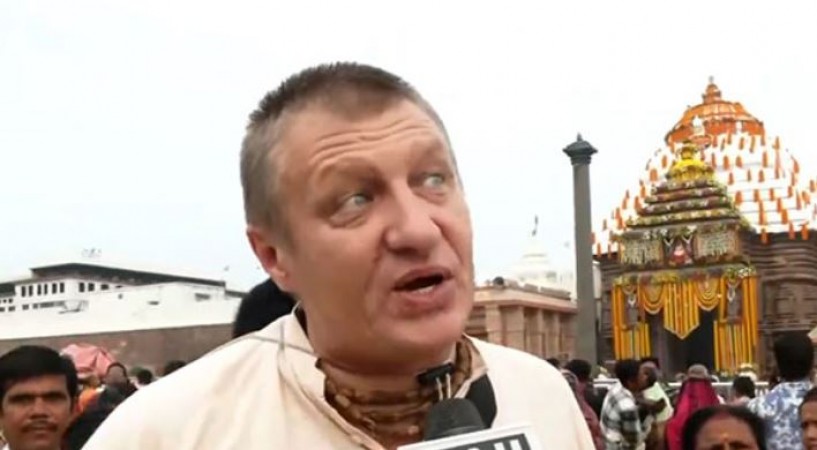
Puri: On the occasion of Deva Snana Purnima on Saturday, devotees from across the country and some from abroad gathered in Puri to witness the 'snana yatra' of Lord Jagannath and his siblings, Balabhadra and Devi Subhadra. This ceremonial bath is a significant event in the Hindu calendar, drawing crowds eager to glimpse the deities.
A Russian devotee shared his deep spiritual connection with Lord Jagannath, expressing that the deity unites all people in divine love. He said, "I have been staying in India for the last 25 years, mostly in Brindaban. I came here to join the 'snana yatra' of Lord Jagannath. This is a great opportunity to see Lord Jagannath. For us, it is possible to have a glimpse only on this day. Lord Jagannath is Krishna. Everyone knows Krishna Janmashtami. Lord Jagannath unites all people in divine love. He is the lord of the Universe. In Kalyuga, Lord Jagannath unites all people with his big eyes. Vasudhaiva Kutumbakam is one big family, and Lord Jagannath is the supreme god."
Another devotee from Bangladesh mentioned the significance of the ritual for thousands of Bangladeshi visitors. "Every year, we come here during Deva Snana Purnima. We watch Lord Jagannath, Balabhadra, and Devi Subhadra taking bath together. After the bath, Lord Jagannath becomes unwell, and for 15 days, we don't get the darshan. After that, the Rath Yatra commences. Thousands of people come from Bangladesh to witness the bathing ritual because the Puranas state that those who watch it will attain salvation. In Bangladesh, there are also many Lord Jagannath temples."
The Deva Snana Purnima commenced this morning with the deities being brought to the Snana Mandap for their ceremonial bath. The festival, also known as 'Snana Yatra', is celebrated on the full moon day of the Hindu month of Jyeshtha, usually in June. This day is believed to mark the birthday of Lord Jagannath, and the ritual holds immense religious significance. The deities are taken out in a grand procession from the sanctum sanctorum of the Jagannath Temple to the Snana Mandap, an elevated platform where the bathing ritual takes place.
During the Snana Yatra, Lord Jagannath, along with Balabhadra and Subhadra, undergoes a ceremonial bath with 108 pitchers of sacred water. After the bath, the deities are adorned in Gajanan Besa, resembling Ganesha, the elephant-headed deity. This unique attire, also known as Hati Besa, has deep symbolic meaning. This is one of the rare occasions when the deities are publicly visible, providing devotees with a close view before the famous Rath Yatra.
Following the bath, it is believed that the deities become unwell and are moved into a period of seclusion known as "Anavasara," where they are kept away from public view for about 15 days. This period is considered a time of recuperation, as the deities are believed to suffer from fever due to the extensive bathing ritual. During Anavasara, special medicinal preparations known as 'Phuluri Tela' are offered to aid their recovery. Devotees can glimpse the 'Patti Dians' (painted images) of the deities during this time instead of the actual idols.
After the Anavasara period, the deities re-emerge for the grand Rath Yatra, where they are placed on magnificent chariots and taken in a procession through the streets of Puri. This marks their annual journey to the Gundicha Temple, one of the most celebrated and attended events, symbolising their blessing and grace upon all devotees.
Vision for the Future: Sheikh Hasina Discusses Vision 2041 and Viksit Bharat 2047
OPPO Launches F27 Pro Plus 5G in India: Specifications, Pricing, and Offers